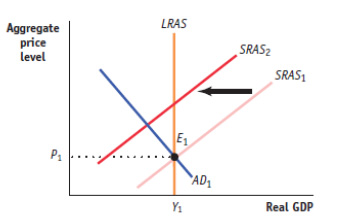Question
In the accompanying diagram, the economy is in longrun macroeconomic equilibrium at point E1. Suppose that there is a temporary, but significant, increase in oil
In the accompanying diagram, the economy is in longrun
macroeconomic equilibrium at point E1. Suppose that there is a
temporary, but significant, increase in oil prices in an economy with
an upward-sloping SRAS curve. Based on the diagram, answer the
following questions.
a. How do the aggregate price level and aggregate output
change in the short run as a result of the oil shock? What is
this phenomenon known as?
b. If policymakers wish to prevent the equilibrium price level
from changing in response to the oil price increase, should
they increase or decrease the quantity of money in circulation? Why?
a. Suppose that there is a temporary, but significant, increase in oil prices in an economy with an
upward-sloping SRAS curve. In this case, however, suppose that policymakers wish to prevent
equilibrium real GDP from changing in response to the oil price increase. Should they increase or
decrease the quantity of money in circulation? Why?
b. Can policymakers stabilize both the price level and real GDP simultaneously in response to a
short-lived but sudden rise in oil prices? Explain briefly.

Step by Step Solution
There are 3 Steps involved in it
Step: 1

Get Instant Access to Expert-Tailored Solutions
See step-by-step solutions with expert insights and AI powered tools for academic success
Step: 2

Step: 3

Ace Your Homework with AI
Get the answers you need in no time with our AI-driven, step-by-step assistance
Get Started


